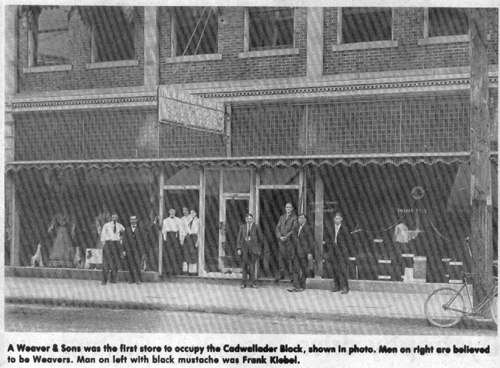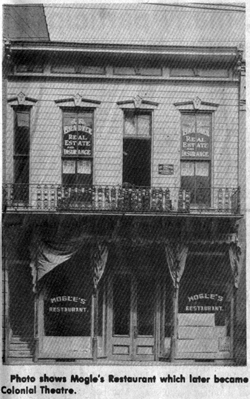September 10, 1981


Picture #1 – A Weaver & Sons was the first store to occupy the Cadwallader Block, shown in photo. Men on right are believed to be Weavers. Man on left with black mustache was Frank Kiebel.
Picture #2 – Photo shows Mogle’s restaurant which later became Colonial Theatre.
Last week’s story ended with the Botto Block, but the photo showed the Cadwallader Block on the extreme right. Today’s article starts with descriptive copy of it and proceeds with the narrative of the Colonial Theatre and Fletcher Bros. Meat Market, which was just south of it.
The Cadwallader Block was built in 1907. From its inception up until a few years ago, when The Ahlenias Co. quit business, that building apparently was used exclusive by dry goods merchants for 67 years.
The A. Weaver & Sons Co. moved into the Cadwallader building (120-122) in 1907. Originally it was known as Waver & Adams, a partnership formed with Thomas D. Adams in 1875, which existed until 1885. They were located at 105 N. Main St. and remained there until 1893.
In 1892, when the Emerine Block at the corner of Main and Center, was nearly completed, the A Weaver Co. as it was known then, was planning to move into it. A fire which was thought to be incendiary, destroyed nearly all of the buildings interior. That catastrophe caused Weaver to remain at 105 N. Main until the Emerine building was restored. Weaver had already moved merchandise, all of which was destroyed, into the building prior to the fire. So, it was 1893 before they finally relocated and occupied three floors of the new building.
The larger photo on the page shows A. Weaver & Sons after they moved to 120-122 where they continued until about 1915. The stockholders of A Weaver & Sons, in addition to the principal were sons: D.D., W.W., A.J., D.T., Frank Kiebel, J. Fosty and Wallace Lynch.
OTHER DRY GOODS STORES
Older readers will recall some of the following names and faces of employees who worked for Weaver and its successor, The Kiebel and Wilson Dry Goods Co.: May Swartout, Dora Rosenberg, Margaret Hatchet, Katherine Hood, Katherine Fletcher, Jessie Ernest, Edna Ohle, Nelle McConnell, Bertha Mickey, Bertha Yost, Fred Helrigle, Ray Clark and John Livingston.
Kiebel & Wilson was first listed in the 1915 directory, with officers: John Fosty, president; Frank Kiebel, vice president; and L.D. Wilson, secretary and treasurer.
The 1919-20 directory showed that Kiebel & Wilson had become The Wilson Dry Goods Co., the principal being D. Wilson. The company was still listed in the 1922 directory.
Beckett & Ahlenius took over that location in about 1923, which still later became H.O. Ahlenius Co. and continued until about 1974, when they sold out to New Era, who in turn sold to j. Miller & Co. about a year later. The j Miller Co. have been located in their present location at 106 N. Main Street for five years.
If Harry and Gordon Gair, now living in Florida, were here they could provide an accurate account of the H.O. Ahlenius Co. or The Ahlenius Co. as it was later known. H.O. Ahlenius was their step-father and they were actively engaged in the business after his death, along with Stuart Gair, deceased, until time of its dissolution. As I said earlier that location had always been a dry goods store. It seems as if a magic wand must have been waved over the building by a fairy weaver of materials to make it such.
COLONIAL THEATRE
In the center of the main photo above, readers will recognize the old Colonial Theatre, and its marquee, which was removed recently in preparation for the Streetscape program.
But, before there was a theatre there it was just another two-story building to accommodate the needs of the booming town. One of the other photos on the page shows it, with Mogle’s Restaurant on the first floor and J.R. Bradner offices on the second floor. Bradner was the father of Harry 1019 Lincoln Ave.
A conversation with Oletha Buck Gutknecht provided information I didn’t know, and reminded me of things I had forgotten. Her father, Art Buck, started the theatre in 1916, along with four other stockholders: Ural, his brother, Melvin Hawkins and Charles Mergenthaler, another Main street businessman.
Prior to the advent of the Colonial, Art Buck was involved with the Majestic Theatre directly across the street.
COLONIAL ENLARGED
The Colonial was originally only as wide as the building shown in the one photo. Later, the rear of the adjoining building was acquired, which allowed more seating capacity and a balcony. It also allowed the building of a wide stage to present stage shows. There was a pit for an orchestra, also an organ as well as a piano.
Playing those were Lauda Buck Cover, Chaire Kelly, Alma Kinn, Ruth Powell was the violinist and Wilbur Shultz, clarinetist.
Readers will recall Lucy Smith who worked in the ticket office for many years.
Art Buck was civic minded. He provided free shows for kids on Saturday mornings and open house during Christmas shopping days, to allow shoppers to drop in for a rest period and relax while watching screen entertainment.
The Colonial, like other movie houses, suffered a decline with the growth of television…and consequently our town no longer has a downtown movie house, whereas at one time it had many.
In later years, the Colonial was leased to the Schine Theatres Co., and it became known as the State Theatre.
CITY’S FIRST MOVIE
Recently, when working on this article I visited Mrs. C.W. Gillard, 427 W. Fremont St. to show her the large photo used with the series, and to ask her help in identifying people in the photo. During our conversation I learned that she plated piano in Fostoria’s silent movie house on South Main Street. A photo of it, the Luna, was in Potluck Feb. 5, 1981. At that time she was still attending school in Fostoria’s Old Central High, and Ural Buck was the projectionist. She couldn’t recall the name of the young man who provided sound effects…the clatter of horse hoofs, a knock at the door, the firing of a gun, a ladies scream in distress, etc.
Before our visit ended, Mrs. Gilliard seated herself at one of her two pianos and demonstrated her mastery of the keys after all those years. She told me that at one time she gave as many as 18 piano lessons to youngsters on Saturdays.
ANOTHER DESTINY
The other subject of today’s story is the building shown in extreme right of the large photo. It too seemed to be destined to house one type of merchant. ..in this case meat merchants. When the photo was taken it was Fletcher Bros.
Earlier in about 1915 it was W.L. Warner Meats.
Bazley Cash Market chain took over the room in 1930 and remained there until about 1957, when they were last listed in the directory. In 1947, the store became known as Bazley and Junedale Market. During those 27 years in the same location the store had nine managers, the first being Robert Barvin and the last was W.D. Haughwout. The others in order were: H.J. Wheeler, G.M. Henry, E.J. Wickert, C.E. Gilbert. Carlton Hauser served longer than any, for nine years from 1942-1951.
REMEMBER FREDDIE?
Older readers will recall that Fred Helegrink, a taylor, occupied the rooms at 116 1/2, above the meat market around 1915 for a period of time. He was a well-known comical man, of small stature, with broken English often seen hurrying about Main Street, with a pair of men’s trousers, or some other garment over his arm.
When Bazley quit business, the building stood vacant until 1964, when Ash Hat Shop moved in and stayed until 1972. Lela McAnaney managed the shop for the first six years and Marguerite Ferguson until it closed.
Incidentally, Bazley owned the building but the only reason they quit business in Fostoria was because they were having a problem getting permission for trucks to park in the alley to unload meat supplies.
The building then stood vacant for two years until Pizza Villa moved in in 1975. They are still there.
Our story for today ends with the east-west alley which divided Main between Center and North Streets.